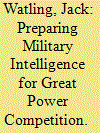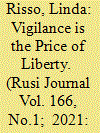| Srl | Item |
| 1 |
ID:
180499


|
|
|
|
|
| Summary/Abstract |
Traditionally, navies have tended to prioritise blue-water capabilities over green- or brown-water capabilities. However, although peripheral, maritime assets have been employed with a high degree of success in irregular conflicts and operations short of war. Andrew Thomas White highlights the historical importance of maritime assets within counterinsurgency campaigns, and argues that despite the renewed emphasis on the potential for great power conflict in contemporary times, maritime counterinsurgency assets, skills and knowledge must be maintained and honed, rather than cast off to the margins of naval debate.
|
|
|
|
|
|
|
|
|
|
|
|
|
|
|
|
| 2 |
ID:
180495


|
|
|
|
|
| Summary/Abstract |
Lethal autonomous weapon systems (LAWS) – robotic weapons that have the ability to sense and act unilaterally depending on how they are programmed – will be capable of selecting targets and delivering lethality without any human interaction. This technology may still be in its infancy, but both semi-autonomous and other precursor systems are already in service. This, argues Paddy Walker, requires a material step change in both hardware and software but, once deployed, posits a significant change in how humans wage war. This article considers the behavioural and leadership challenges that arise from the deployment of such weapons and how unsupervised engagements might degrade the commander’s craft.
|
|
|
|
|
|
|
|
|
|
|
|
|
|
|
|
| 3 |
ID:
180500


|
|
|
|
|
| Summary/Abstract |
Military intelligence (MI) is critical to visions of future war. The analytical methodologies of the War on Terror have reshaped how MI teams are trained and deployed. MI personnel are increasingly specialised, with experience and judgement being replaced by rigid adherence to robust data-driven analytical methodologies. While these methods are likely to continue at higher echelons, Jack Watling argues that a large MI presence at the tactical edge will not be practical under the indirect fire threat on the future battlefield. Furthermore, reach-back to higher echelon support will be severely constrained in a contested electromagnetic environment. Tactical echelons will therefore need an expanded organic MI capability, with experienced personnel able to perform a wide range of MI functions.
|
|
|
|
|
|
|
|
|
|
|
|
|
|
|
|
| 4 |
ID:
180496


|
|
|
|
|
| Summary/Abstract |
UAVs have been used by non-state actors in the past decade. However, no known attack by right-wing extremists has been carried out using them. Håvard Haugstvedt reviews recent developments in attacks – through online activity in open forums and by examining groups that have already used UAVs in their operations – by such actors, to explore the possibility of right-wing extremists adopting UAVs. The article argues that right-wing extremist groups lack a strong entity, such as a state, backing their development and operations. However, terrorist groups learn from one another, and as extreme right-wing ideologies have gained currency among some members of the military and law enforcement agencies, the capability to develop and use UAVs may be more possible than that which has been revealed thus far. Nonetheless, this article casts doubt on right-wing extremists’ capability and desire to incorporate UAVs into a violent repertoire that has historically been composed of fists, fires and firearms.
|
|
|
|
|
|
|
|
|
|
|
|
|
|
|
|
| 5 |
ID:
180497


|
|
|
|
|
| Summary/Abstract |
Recent global trends have brought questions of intellectual property (IP) theft to the fore. The fear is that stolen IP, whether gained through hacking, human intelligence or legal means, could threaten the technological edge of Western militaries. There are many nuanced attack vectors. Rebecca Lucas and Trevor Taylor argue that Western governments will have to adopt a whole-of-government approach, as well as collaborating with allies and partners, to effectively address this challenge.
|
|
|
|
|
|
|
|
|
|
|
|
|
|
|
|
| 6 |
ID:
180502


|
|
|
| 7 |
ID:
180498


|
|
|
|
|
| Summary/Abstract |
The Supreme Headquarters Allied Powers Europe (SHAPE) is the only integrated command to exist in peacetime. Established in the aftermath of the Second World War, its existence is embedded in the multilateral approach to international relations and defence that characterised the post-war years. Today, as NATO adapts to the new security environment, so does SHAPE. In this article, Linda Risso offers a historical analysis of SHAPE’s development over the past seven decades and examines how the operational headquarters is preparing for the new challenges that the Alliance is facing.
|
|
|
|
|
|
|
|
|
|
|
|
|
|
|
|
| 8 |
ID:
180501


|
|
|
|
|
| Summary/Abstract |
Plagued by years of conflict and tragic humanitarian crisis, the people of Yemen face an increasing struggle to survive. Susan Schulman travelled to Yemen and spoke to some of the people trying to make a living in a country where human intervention and climate change have turned a once fertile land into one where water is the most precious and elusive resource of all.
|
|
|
|
|
|
|
|
|
|
|
|
|
|
|
|